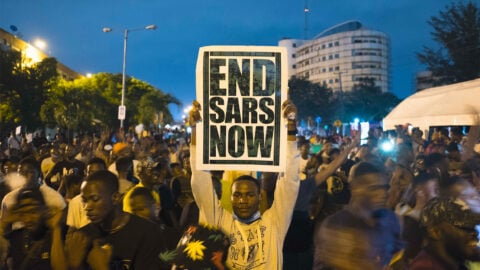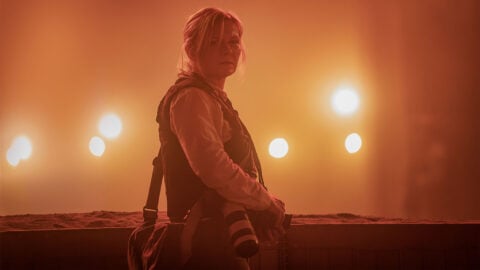Interview: Kirill Mikhanovsky and Alice Austen
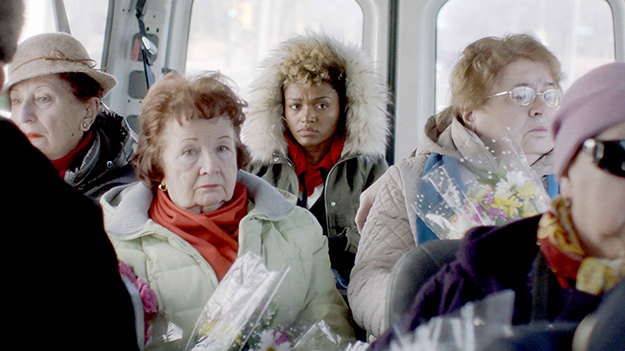
Images from Give Me Liberty (Kirill Mikhanovsky, 2019)
Directed, co-written, and edited by Kirill Mikhanovsky, Give Me Liberty is one of the most exuberant, ingeniously made, and humane American independent films of a decade in which too many aspiring directors have become risk-adverse. Mikhanovsky and his Russian Jewish family emigrated to the United States and settled in Milwaukee in the mid-1990s. He did a degree in linguistics, but he was movie mad. His first feature, the 2006 Sonhos de Peixe, is set in Brazil and though small by comparison, displays a similar ethnographic approach to persons and place as does Give Me Liberty. Quite a few years ago, Mikhanovsky teamed up with playwright Alice Austen to write a script based on his experiences as a van driver for people with disabilities. The script went through many revisions, financing was difficult, but Mikhanovsky and Austen stuck to their original idea of making the film entirely in Milwaukee and casting it almost entirely with nonprofessional actors, many of them elderly or disabled.
The narrative takes place in a single day. The central location is the van, and its driver, Vic (Chris Galust) is the connecting link between the film’s wildly diverse characters, among them Tracy (radiant, sharp-tongued Lauren “Lolo” Spencer, who, like her character, is wheelchair dependent). Tracy is perpetually annoyed with Vic, because soft-heartedly he gives rides to friends and relatives, making her late for work. Among Vic’s non-clients are a chorus of 80-plus-year old Russian women, who practice “Go Down Moses” on their way to sing at the funeral of a woman who might have been the love of Vic’s demented grandfather’s life. Along for the ride also is a volatile boxer who claims to be the dead woman’s nephew and who will later try to seduce Vic’s sister who responds with quietly manic ambivalence. These two characters are played by brilliant Russian actors (Max Stolanov and Darya Ekamasova) but they fit right in with dozens of people who had never performed for the camera but rise to the occasion with commitment and joy. If you’ve ever described a film as being rich with life, it has nothing on Give Me Liberty.
I spoke by phone with Mikhanovsky and Austen, who at the time were in Milwaukee preparing for the film’s opening, which was in late August. [Give Me Liberty had its world premiere at Sundance and also screened in Cannes.]
I didn’t see your film in Sundance, nor at Cannes, nor at the BAMcinemaFEST. I don’t know why I resisted it so much, but I then went to a press screening and I think it’s terrific.
Kirill Mikhanovsky: We need to hear that because, after all the battles we’ve fought to bring it to existence, opening in America is the biggest battle we’ve faced.
Alice Austen: It’s extraordinarily difficult with the way distribution is now.
How did you make the decision to shoot such a difficult movie on film? It’s at least partly shot on film, isn’t it?
KM: Part of it was. This was the ethos from the get-go. I come from an extensive shooting-on-film history. Alice and I found a common ethos, a common ground that we share, which is humanism. And that fragile medium of celluloid, which is going away, or being done away with by marketing, represents humanity in cinema better than any other medium. So we made the decision to shoot on film early on, but sadly, we weren’t able to do all of it that way. In 2017, when it looked like we wouldn’t be able to get all the money, we decided to go ahead no matter what, so we shot part of it digitally and part on film.
AA: And wherever we could, we were re-organizing days to shoot on film. It got extraordinarily difficult. We even used this Russian wind-up camera when we couldn’t afford to use the big camera.
KM: It was very fitting, Basically, it’s like an old war reporting camera which runs for about 30 seconds, and then it stops. Given the difficult on-and-off state of getting the film made, it was a very fitting technique.
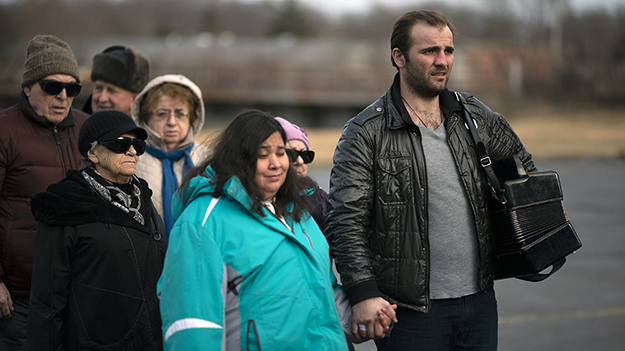
How complete was the script when you went into production? In other words, was the dialogue there or was the dialogue improvised? What kind of script was it?
AA: We wrote a very tight, very structured script which was what we originally wanted to make. It kind of caught the zeitgeist, and a lot of known actors wanted to be in the movie at one point. And some of that very tight scripted dialogue is still there, but many things changed.
KM: Alice and I had discussions about a lot of subjects, and one of the more heated discussions has been and continues to be about the role of the script. My dream is to make a Hitchcockian film where everything is just set in stone. To paraphrase his quote: you can just feed it to a machine, and the machine will output a movie. That way you skip all the hurdles and pain during production. But with this one, we set out to make it in Milwaukee with a largely nonprofessional cast before we had a single line written. So of course my dream strategy had to change to make this movie. I’ll quote another filmmaker of the 20th century, the Georgian Otar Iosseliani, who used to be in the habit of saying that you write one film, then you storyboard and it’s another film, then you film it and it’s a third film, then you edit it and it’s the fourth film, then you do sound and it’s a fifth film. Basically, by the time you have the film, it’s a totally different film from the script—which existed strictly for producers to get it financed. [Laughs] Alice wrote the script and at one point the narrative took place over eight to 10 days. It was a much wilder version than what you saw on the screen.
AA: Now it’s utterly tame.
KM: At one point we took a break and shot another film, in nine days, an 82-minute mystical thriller that’s still in post-production. Then we put that on the back burner and returned to Give Me Liberty. When we did, it occurred to Alice that the script needed a major revision in order to turn it into 24 hours in the life of Vic, the main character. And of course, that new version of the script was fully structured. But at the same time, I look at the script as a plan that allows me to bring all of the elements into a location, and make it alive and go from there and allow life to enter the scene and modify to the extremes. As long as there is life and we can capture it, then that’s what really matters. But still many scenes emulate what was on paper. Many, many lines are exactly as they were written, but many other lines are new, either brought by our nonprofessional actors—there were some things that were born out of the instance, out of the magic of the moment.
The whole purpose of working with non-actors, something I learned from the neorealists, is that they bring their life baggage with them. We were working with real people, with real disabilities. They bring their joy and pain to the screen—something no actor can learn or be taught, especially given the no-time and no-money situation we were in. And all this energy and their experience and their language infuses the structure. Like the yoga sequence. Our 88-year-old debutante, if you will, suggested he knew how to do yoga. And there he was, on the floor, doing yoga! That was certainly not on paper. I had no idea that he was capable of doing those moves.
AA: Another thing that happened is that I became the producer. I thought of myself as a writer. But there were a lot of times on set where something would arise, and it would really shift our production plan, and it would really make our AD just crazy. But as someone who had written the script with Kirill and understood the structure and the big picture, I could make what was already a difficult process much easier because I would say, “No, no, no, Kirill, this is absolutely right. We must do this.” And I could understand how something threw off the game plan. So I could say, “We have to re-capture something else the day after tomorrow, and we can do that.” So, Kirill and I worked together really beautifully—it was difficult to pull off, but we pulled it off. [Laughs]
KM: I’ll try give you some of quotes that we wanted to put on the poster. These were real quotes from real people, basically the nay-sayer quotes. “Unproducible,” “Uncastable,” “Lovely film, but you have no chance at Sundance,” “Unmarketable,” “You can’t hold out for Cannes, it would never get in.” Every step of the movie, we had to thwart these naysayers , and move on. This is the epitome of the American dream by which we stand—we became people stronger than the people we started out as with this film.
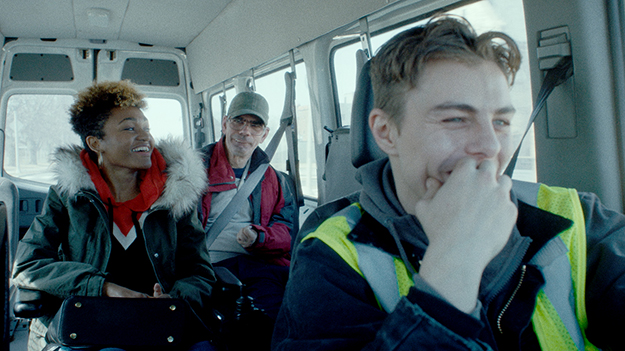
How much material did you end up with? Did you have lots of scenes that you let go of? Part of what makes the movie so great is the pace of it. And the things that thread it together. Like the van’s dispatcher constantly radioing Vic that he has to be at his destination in 10 minutes and where the hell is he. And the way the sound bridges a scene that ends abruptly with the next scene that starts just as abruptly. And there are the pleasurable elements—food and music—and they keep recurring in different contexts. I’m just curious if you threw stuff away, and what that stuff is like, and I’d be very curious to see it. [Laughs]
AA: We did follow that structural line, and we did some pick-up photography to connect the pieces that had been lost, because we’d understood that the film had both this incredible life in the moment and an incredible structure, so we tried to strike a balance.
KM: Alice and I made many decisions early on without considering other options. For instance, when our financing fell through, it never occurred to us to reduce the number of scenes or to go with limited number of characters. And given the number of locations and characters and given our absence of money, and that there were some participants in their nineties and who were in constant pain, and there were people who had disabilities, you need time. You need time to pay attention, to rest, to care for the people. We were looking at probably with fairness 40 to 50 shooting days. What we had was about 23 days. Just to give you an idea—we had the van with all the participants, we said it would take one hour. But just to get everyone off the van: one hour. To get to the location where we’re driving, another 30 to 40 minutes, another hour. One hour more, we’re losing time, wasting time. Moving from location to another location, that’s another one- to two-hour company move. We had no time. So, just to give you an idea, these 23 days, we were running for our life.
Everybody was unprepared because nobody knew, one month out of shooting the film, if we were going to be able to make the movie. And then we said, go! And we only had eight days to prepare the lead actor for his first role ever, and of these days, I had only one hour with him to tell him about the character. Basically, nobody was fully prepared to do this. And we did it.
AA: There were a number of people attached to the project for a long time, and there was this extraordinary energy that was a function of this collection of people who wanted to make this film. And we captured it so it was a very useful process.
KM: This film is made of three things. One of these things is what Alice said, which is the combined energy of all the good forces that made this film happen. The second is that we stuck to our guns about shooting in Milwaukee and our idea of working with nonprofessional actors. Because there were times when we were close to shooting somewhere else where there might be a tax incentive so we could have a bigger budget, or when it was suggested that we should budget up so that we could cast Lupita Nyong’o in the main role. But we stuck to our ethos and said she’s a wonderful actress but we want to cast a non-actor. And the third thing is that we went at it full force. We were obviously mad people who were running for our lives. We were on the wild run to grab reality. And reality was resisting us with the same amount of ferocity. And these two waves of energy clashed and created this magical energy, that was the third component that we had the fortune of capturing on camera. And at the end of the day, my job was to be able to see that and preserve it—really honor the material and find the life that is already there, and make it into a movie.
AA: I think in a lot of other projects, there’s this “follow the money” rule, and I think our rule might’ve been “follow the energy.” When we were shooting, I’d put myself through the hell, frankly, of watching dailies. We weren’t sleeping at all, but I wanted to be sure we were getting enough, and that I knew we had a film. I would remember a take which was good, and Kirill would say, “Yeah, this is great.” One of the problems was that we had people who had never been in a movie. They didn’t know about continuity. We didn’t have a continuity person to say, “You’ve got a red barbell, but you had a blue barbell!” Just little things with no one person doing continuity. We relied on a combination of our production designer Bart Mangrum, our cinematographer Wyatt Garfield, and ourselves.
KM: I don’t want to say that we’re proud of it, but the fact that we did this film the way cinema should be made—there’s something to say for it in the age of digital technology and gadgets and devices.
AA: Green screens and—
KM: Whatnot. This is raw. And I don’t think anyone in their right mind would ask for this experience. We did not ask for it, but now that it’s over, we can say that it was truly a blessing in a terrible disguise.
AA: Our young lead actor is an electrician. Jennifer Venditti, our casting director, discovered him buying a cake for his grandfather in celebration of the 25th anniversary of his coming to America from Russia. So he speaks Russian, and also, he drives an electrical van in Brooklyn, so he’s a brilliant driver. There was a point when we were Skyping with all of these talented, experienced young actors who really wanted to do the movie. I look back and think oh my god, if we had cast someone who was used to driving on the left, it would’ve been impossible! Chris actually drove, and he drove really, really well. And without a great driver behind the wheel, we would’ve been lost.
Kirill, you edited the film. Could you talk about that process.
KM: When I had to look over the materials in the editing suite, it was like a chamber of horror for me. Every day, I would call Alice and say, “It’s over. We don’t have it.” And then I would spend one more day and things would lighten up a little bit. We’d see something has happened there, then two more days: “Okay, I’m discovering…” This was the most challenging thing I’ve done as an editor. Editing is linguistics and I had a mixed bag of goods to build sentences. I realized that I couldn’t stick to my old rules of editing. I needed to find the movie within the rock—within the body of what we had. And yes, of course, there is a beginning, there is a middle part, there is an ending, but I also had to invent a new language for me. If two years ago you told me this would be the movie, I would have said, “This is crazy! No, there is no way in the world that I will use that camera, that angle, that editing device. No! These are not part of my rules. This is not me.” So my job, as an editor, was to listen to the material, and listen and look for the film that is there, but is hard to see. And about three weeks into the process, I think I felt some energy, and at that point, I told Alice: “I think there’s something really interesting happening there. Let’s sit down and watch it.”
Something else is that sound was a huge part of it. We’ve all learned from Walter Murch, who edited both image and sound. For me, it’s the same. Sound often guides my visual editing process, and here sound saved my editing in a lot of ways. I realized at some point that I wanted the audience to follow the action, to catch up with the action. I’m familiar with the device where sound precedes and announces the arrival of the next scene. I never used it in my life, but this time I said I’m going to use it in every damn scene and every damn shot. And then I realized that Vic, the main character, is playing catch-up in the movie all day long. So with sound, almost subliminally, you almost need for the picture to catch up with it. You need to arrive at the next scene while we’re still in the previous scene. You’re playing catch-up as an audience. So it became a device, it became a theme, and it really plays well with this one, because it accelerates everything.
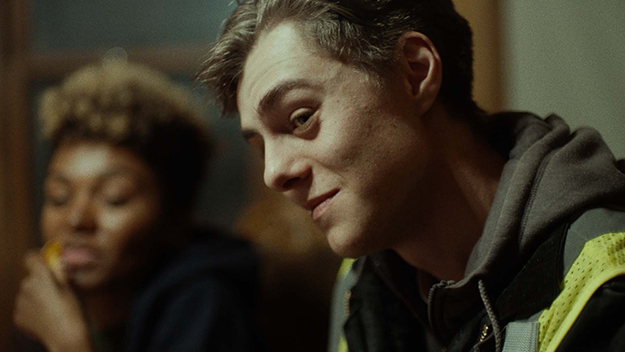
What about the chorus of elderly Russian women who sing at Vic’s aunt’s funeral? How did you find them?
KM: My mom brought them to my attention. She is a great force of nature, and was trying to help out as much as she could, with oranges on the set or chicken—
Your mother was on the set?!
KM: Yeah, and she also has a small little cameo. She said, “You wanna use this choir in this film? I met them, fell in love with them,” and then for two and a half or three years that we tried to raise money, I kept following them, just recording their productions. They have a production every half a year—
AA: And a YouTube channel!
KM: The head of the choir writes all the scripts, she does all the costumes for them, she does all the production design singlehandedly. A true force of nature. She committed with her theater to the production. They were waiting on standby for three years. During the production, she got pneumonia, but she told to us that in the Soviet Union, she was taught to deliver on her promise. And she did. This is also one of the many reasons why we refused to take the film somewhere else. We cast so much of it from the streets of Milwaukee.
AA: When you asked if there was something that didn’t get into the movie, yes there is. We shot the chorus on film singing “God Bless America” in these extraordinary costumes at the Wisconsin African American Women’s Center. But “God Bless America,” which was written by Irving Berlin who donated his royalties to the Boy Scouts, is really expensive. So the irony is that this song written by a young Russian-Jewish immigrant to America seems so fitting in so many ways, but we couldn’t use it.
KM: Actually, the first thing that I recorded on that small Russian camera years ago was the chorus. And think about it: we are talking about people who grew up and spent their whole lives on the other side of the Iron Curtain. Some of them were in the military. Some of them were poised to press the proverbial red button.
AA: One of the guys in the cemetery scene actually had his finger on the red button—
KM: —for 25 years. And now he is here, with his knee successfully replaced, his heart replaced and refortified. He’s part of a choir that celebrates their heritage by singing Jewish songs, Polish songs, American songs.
AA: They’re all quite patriotic.
KM: They’re more patriotic than patriotic people who are born here.
AA: One of the most beautiful things that happened when we wrapped was they made a dinner for us with vodka. And they were giving toasts, it was such an act of generosity after everything we put them through. Really moving.
KM: They were in pain, needless to say. They are old, the van was really old, filled with diesel fumes. People were coughing just choking on it, and we had up to 15 people in the van speeding at 75 miles per hour. That’s how the film was made. And the behind-the-scenes process was mirrored so strongly what we see on the big screen in an incredible way.
At one point, two of the women in the chorus talk about what life was like in this small part of the Soviet Union, where they remember Poles and Jews and Ukrainians all living happily together. And that memory—I doubt that it’s completely accurate—becomes the aspirational dream of the film. You’ve mentioned that Milwaukee is a segregated city, and it is. But in the film all these people of different races and religions and national origins, who are often very prickly with one another—I love that Tracy is so prickly—come together in remarkable ways.
AA: A friend of mine from grad school came to the BAM screening. She’s African-American and her reaction was similar to yours. She said, “I was expecting to see a really nice, little independent film, and what I saw was revolutionary. And what I love about the film is that it brings us together, because it lets us all be ourselves.” Which I thought was such a beautiful way of articulating what the film ultimately does.
When we were shooting the riot scene, which was another difficult misery because it was so cold, we had these extraordinary extras who we really connected to all sides of the city throughout the course of making the film. And when we were casting, one of the questions we asked was: what do you love about Milwaukee and what don’t you love? And uniformly everyone—black, white, from whatever walk of life, demographic—just about everyone said they hated the segregation. There was a real desire to overcome it from the inhabitants of the city. Many of the extras came from the inner city, and the security for the film were white police officers who worked the actual riots in Milwaukee. And they were weighing in, which is also kind of comical because they were quoting the chants that had been thrown at them at 2 a.m. in the freezing cold. I remember walking in a day later, sitting down with these white police officers, and starting a conversation about what we can do to make our city a better place together. And this is a conversation people try to have but find it impossible to carry on. To me, it was such an extraordinary moment to see it happen so naturally and so organically, in the course of making this film, by people who normally would never have done that, you know. So, there was a lot of that, both behind the scenes and in terms of what happens in the story.
Thank you both so much. It’s an extraordinary movie. It made my summer.
Amy Taubin is a contributing editor to Film Comment and Artforum.





